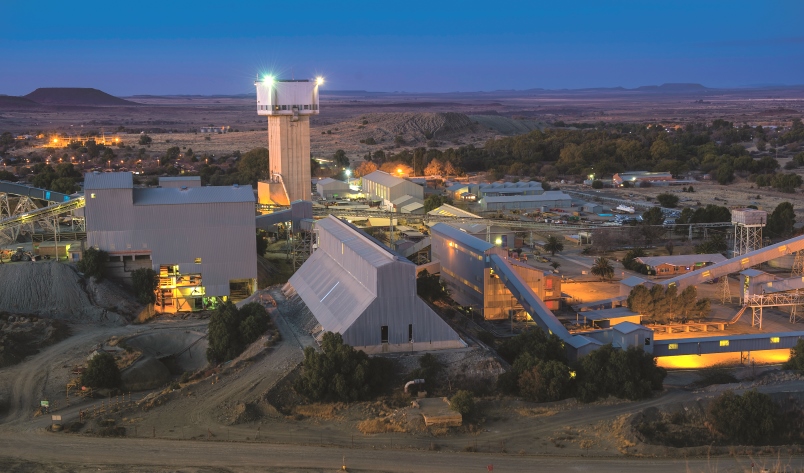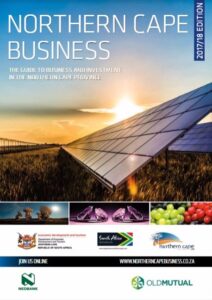By John Young
Mining and agriculture are still enormously important sectors for the province, but renewable energy is growing very fast indeed. The number of solar plants that were developed (and delivered on time) in the Northern Cape in the last five years is truly phenomenal.
In the nationally-run process to encourage the private sector to invest in renewable energy, fully 60% of the projects so far approved have been allocated to the Northern Cape. This represents 66% of the nearly R200-billion invested or pledged to date. The Northern Cape is particularly well-suited to solar energy installations and both of the main technologies (photo-voltaic and concentrated solar power or CSP) are being installed all over the province. The towns of Upington and De Aar are seen as possible future hubs for the further development of solar power-related industry.
The planned Special Economic Zone at Upington (linked to the Upington International Airport) is seen as a possible site for solar-related manufacturing.
One the biggest funders of the renewable energy programme, the Industrial Development Corporation, has spent R11.4-billion of its commitment so far in the Northern Cape, out of a total of R14.2-billion. Part of the IDC’s role has been to take up a 20% stake in the projects on behalf of local communities.
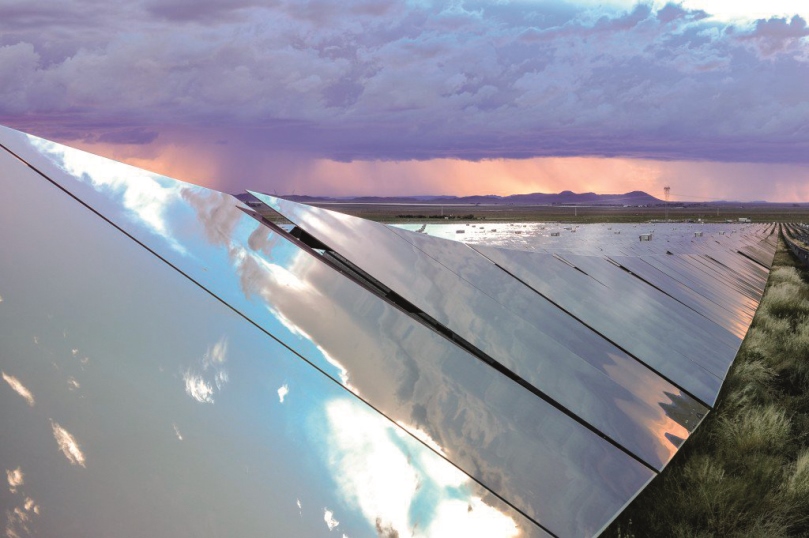
A major new investment in zinc extraction by Indian firm Vedanta and an uptick in iron-ore prices going into 2017 has revived the mining outlook after some tough times. The IDC also has a stake in this mine. Diamond mine Petra Diamonds reports good progress on its mines in and around Kimberley.
On the scientific front, the Northern Cape is hosting one of the great projects of the age, the Square Kilometre Array (SKA) radio telescope, a multi-national effort that will delve into the secrets of the universe from a base in Carnarvon in the Karoo.
The province’s new university in Kimberley, the Sol Plaatje University, gives Northern Cape students a chance to study at tertiary level without having to incur the expense and inconvenience of travelling outside the province.
The rise of the renewable energy sector has given the Northern Cape a chance to break its dependence on the mining sector, subject as it is to global price fluctuations. The provincial government of the Northern Cape has a number of schemes to further diversify the economy and to find ways to further sustain the mining industry in the province. To that end, the government held three summits in 2016. These dealt with small, medium and micro enterprises and procurement, renewable energy and mining.
In the longer term, the provincial government has identified three key clusters that it wants to concentrate on. These are:
- Mineral beneficiation
- Agri-processing
- Energy and technology.
Geography
The Northern Cape is South Africa’s largest province, covering 30% of the country’s landmass on the dry western side of the country bordering the Atlantic Ocean, Namibia and Botswana. The provincial population of just over a million represents 2.2% of the country’s population and the principal languages are Afrikaans (54%) and Setswana (33%). The San people live in the arid regions of the north.
The province is well served in transport and communications, despite its vast size (361 830 square kilometres). Airports at Kimberley and Upington are quite substantial and many smaller towns, mines and game reserves have landing strips. Although the province has many roads, maintaining them is a very difficult and expensive task.
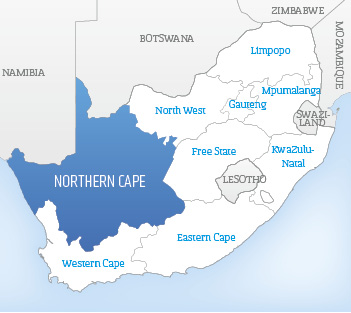 The Northern Cape does not have a major port although Port Nolloth serves as an adequate fishing harbour. Investigations into the creation of a deep-water port are well advanced. Another project could see the province’s small harbours and bays developed as well. A unit within the national Department of Public Works aims to spark economic development in coastal areas.
The Northern Cape does not have a major port although Port Nolloth serves as an adequate fishing harbour. Investigations into the creation of a deep-water port are well advanced. Another project could see the province’s small harbours and bays developed as well. A unit within the national Department of Public Works aims to spark economic development in coastal areas.
The Orange River is the most important geographical feature of the province, providing irrigation to support a thriving grape, sultana and wine industry. One small hydro-electric power scheme has been approved, but the potential for more such schemes is massive.
Other crops such as lucerne, cotton, wheat, peanuts and maize are grown in the Orange River Valley and in other irrigation scheme areas such as the Vaalharts Irrigation Scheme in the eastern part of the province. Sheep and goats are the most popular livestock, and horse-breeding is a lucrative activity.
The Northern Cape is home to six national parks and five provincial parks and nature reserves. The Richtersveld Cultural and Botanical Landscape is a World Heritage Site, while the natural spring flower show that appears in Namaqualand is one of the wonders of the world. In 2016 the well-respected international tourist book, Rough Guide, elected the stark beauty of the Richtersveld onto its Top 10 list of places to visit.
Most of the province falls into the category of semi-arid (apart from the coastal strip) and it receives relatively little rainfall. Summers are hot and winters are cold. The western parts of the province are famous for spectacular displays of flowers in spring.
Economy
Mining has long been a mainstay of the provincial economy, contributing 27.6% of provincial GDP (StatsSA). However, only 7% of the population gains employment from the sector: fully 31% are employed in “community services”.
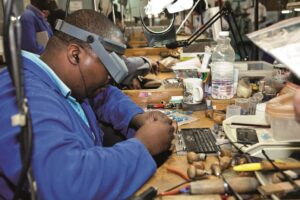 Iron ore and manganese are the two main minerals, with the Sishen-Saldanha rail line being one of the longest and most technically advanced logistics links in the world.
Iron ore and manganese are the two main minerals, with the Sishen-Saldanha rail line being one of the longest and most technically advanced logistics links in the world.
Both the iron ore and manganese sectors experienced terrific growth in the years to 2014, but reduced global demand (mainly from China) has put a dampener on exports.
The Northern Cape is a big contributor to the national basket of exports, not only in minerals but in agricultural products such as table grapes and raisins.
The world receives 7%t of its diamonds from the Northern Cape, and exports of zinc and lead from the province account for 13% of global demand. The figure in manganese is even more impressive – 25% (DEDAT, Northern Cape).
This reliance on an export economy has its risks, as has recently been seen with the laying off of workers at iron-ore mines.
There has been a big change in diamond-mine ownership in the Northern Cape in recent years, with Petra Diamonds buying many of De Beers’ assets. In the Namaqualand area, Trans Hex has acquired former De Beers properties.
The province also has copper, lead, zinc, mineral sands, gypsum, granite, asbestos, fluorspar, semi-precious stones and marble.
About 45 000 people are employed in agriculture, which represents approximately 16% of employment. The province supports livestock farming (mainly goats and sheep with cattle in the north), table grapes, dates, cotton, cereal crops and vineyards along the banks of the Orange River and large varieties of crops including cotton, groundnuts, wheat and maize on irrigated lands (including the large Vaalharts scheme). Thoroughbred horses are bred in the south-western parts of the province, especially around Colesberg.
The Northern Cape is divided into five district municipalities. Each of these districts is suitable for investments in renewable energy, be it wind, solar, hydro or biomass. Many of the districts already have sizable renewable energy plants up and running.
Frances Baard District Municipality
Towns: Kimberley, Barkly West, Warrenton, Hartswater, Jan Kempdorp.
This district accounts for 40.3% of the province’s economic activity. It is the smallest but with a population of approximately 325 500, it is the most densely populated. Although Kimberley is historically renowned for diamond mining, its economy is now driven by its role as the administrative headquarters of the province. Strategically located and with good infrastructure, Kimberley is the leading centre in the province for retail, financial services, education, commerce and light industry.
The Mittah Seperepere Convention Centre and the Sol Plaatje University are in Kimberley.
Mining and agriculture are found in rural municipalities. Agriculture in the region comprises crop cultivation and stock and game farming. The Vaalharts Irrigation Scheme is the largest irrigation project of its kind in the southern hemisphere, and produces maize, cotton, fruit, peanuts and wheat.
Investment opportunities:
- Sol Plaatje University
- Kimberley International Diamond and Jewellery Academy (KIDJA)
- Mining: diamonds and precious stones
- Manufacturing: textiles, agri-processing.
John Taolo Gaetsewe District Municipality
Towns: Kuruman, Kathu, Hotazel.
Kuruman is the headquarters of local government in this region which contributes 19.7% to the province’s economy. The local spring produces 20-million litres of water every day.
Most of the district is situated on the Ghaap Plateau, over 1 000 metres above sea-level, and can experience extreme temperatures. Most agricultural activity is limited to grazing and boer goats are a popular breed among farmers, although game hunting is growing.
Kathu has a well-developed CBD with shopping malls that arose when iron demand was high. The Sishen iron-ore mine outside Kathu is a vast undertaking, providing employment for thousands of people. Samancor’s Mamatwan and Wessels manganese mines and plants are situated at Hotazel.
Investment opportunities:
- Kathu Industrial Park (IDC involvement)
- Eco-tourism and hunting
- Boesmansput diving resort
- Gamagara Mining Corridor
- Goat commercialisation
- Agri-processing: olives, grains, pecan nuts, medicinal plants.
Namakwa District Municipality
Towns: Springbok, Calvinia, Niewoudtville, Garies, Williston, Fraserburg, Sutherland, Pofadder, Okiep, Port Nolloth, Alexander Bay.
The Namakwa district stretches from the north-western corner of the province, and the country, bordering Namibia and the Atlantic Ocean to the southern border with the Western Cape Province. It includes the famous star-gazing town of Sutherland on its southern edge. The district is sparsely populated, and predominantly rural. It contributes 11.1% to economic activity in the province.
A major new investment has been undertaken in zinc at the Gamsberg project at Aggeneys.
The mining and agricultural sectors provide most employment, while tourism and small-scale manufacturing are also present. The region’s economy gets a great boost every spring when tourists flock to see the veld in bloom.
Major plans are being pursued to upgrade the harbour at Port Nolloth and exploit the province’s long coastline as part of a growing awareness of the potential of the maritime economy.
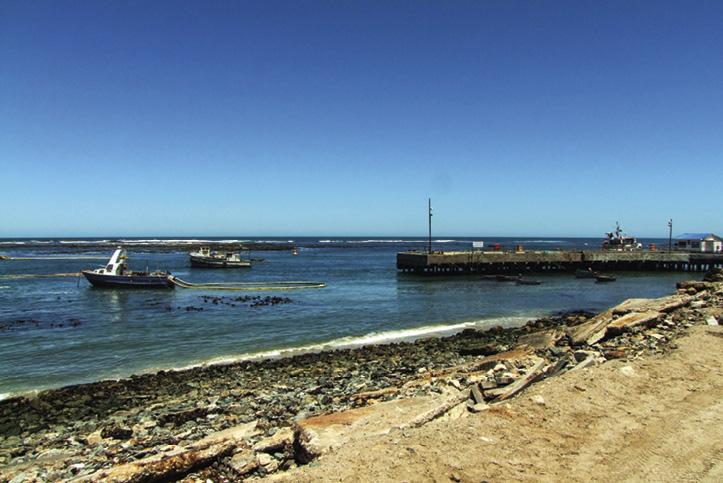
The climate and soil support certain niche crops, and the sites and sights are unique to the region, offering opportunities in agriculture and tourism. Niewoudtville is the site of a rooibos tea factory.
The IAiIAis/Richtersveld Transfrontier Park, the Namakwa National Park and the Tankwa Karoo National Park have the potential to grow as travel destinations, as does the western coastline.
Investment opportunities:
- Port Nolloth and smaller harbours
- Hondeklip Fish Factories
- Abalone and hake
- Kelp processing and export
- Game and nature reserve infrastructure
- Rooibos tea
- Calvinia: sheep and goat processing.
Pixley Ka Seme District Municipality
Towns: De Aar, Hanover, Carnarvon, Douglas, Marydale, Prieska, Hopetown, Richmond, Noupoort, Norvalspont, Colesberg.
The district covers 102 000 square kilometres in the central Karoo and contributes 11.3% of the economic activity of the province. It has four national roads passing through it. De Aar, the site of the municipal headquarters, has national significance as a railway junction.
Carnarvon will now host the Square Kilometre Array (SKA) radio telescope.
The district is home to three of South Africa’s major dams. Agricultural production includes wheat, maize, peanuts, grapes, beans, potatoes, nuts and sheep farming. Pixley Ka Seme is the largest wool-producing district in South Africa, but most of what is produced is processed in the Eastern Cape. As a consequence, opportunities exist for the establishment of a cotton mill, a tannery and a facility to add value to semi-precious stones. Horse breeding is a valuable contributor to the regional economy.
Investment opportunities:
- De Aar rail cargo hub and workshops
- SKA engineering, science, logistics support
- Douglas holiday resort
- Booktown Richmond festivals
- Wool, pistachio nuts and venison processing
- Water tourism activities on dams.
ZF Mgcawu District Municipality
Towns: Upington, Kakamas, Kenhardt, Groblershoop, Postmasberg.
The Orange River supports a thriving agricultural sector and a growing tourism sector. The investment climate is ripe for tourism along the Orange River and attractions such as the Augrabies Falls.
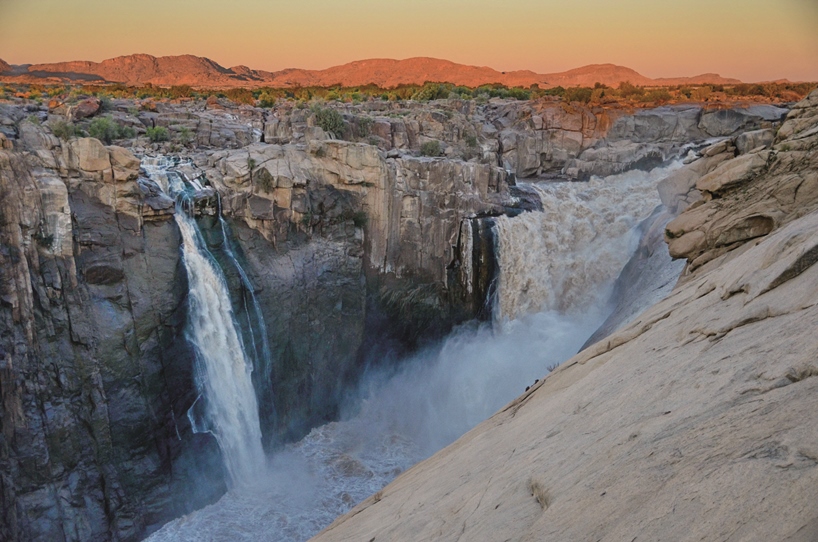
Upington is already a busy town with processing facilities for agricultural products. The planned development of a Special Economic Zone (SEZ) in the town and next to Upington International Airport will boost manufacturing. The main targeted sectors are in the renewable energy sector, for example, solar panels.
Agriculture is a prominent feature of the local economy, as well as wholesale and retail services in and around the town. Various kinds of high-speed car racing and testing takes place on the roads, tracks and airport runway in or near the town.
The processing of wine and dried fruit represents one of the biggest manufacturing activities in the province. Mining activities take place in Kgatelopele, where diamonds and lime are found. Together with sheep and cattle farming, mining provides most employment. The diamond mine at Finsch is Petra Diamonds’ newest and largest acquisition.
Investment opportunities:
- Upington Special Economic Zone
- Upington Cargo and Electronics hub: SKA, renewable energy and aircraft storage
- Upington International Airport
- Orange River Smallholder Farmer Settlement and Development Programme
- Tourism: wine tours, adventure and hunting
- Upington vehicle testing site
- Business Process Outsourcing (BPO).
More information
For more information about any of the investment opportunities mentioned here, please contact the Northern Cape Department of Economic Development & Tourism.
Published in:

